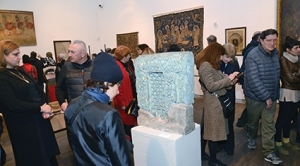Masterpieces of Georgian & World Art: The Past, Present & Future of the Georgian Museum
On March 6, the Georgian National Museum Shalva Amiranashvili Museum of Fine Arts opened the exhibition ‘The Museum of Fine Arts - Yesterday, Today, Tomorrow’ and presented the museum rehabilitation master plan.
The exhibition showcases unique masterpieces of Georgian and world art preserved in the Museum of Fine Arts, which include works by: Bernardo Daddi, Lucas Cranach (Elder), Guido Reni, Jan Steen, Jacob Van Ruisdael, Auguste Rodin, Pablo Picasso, Vassily Kandinski, Robert Falk, Niko Pirosmanashvili, Lado Gudiashvili and David Kakabadze.
Visitors have the possibility to view outstanding pieces of Georgian art, including a small triptych of the Virgin Mary from Ubisa (XIVc.); The Apocalypse - Revelation of John the Divine (I-II cc.); various artifacts made of stone, bone, metal and clay from the Uplistsikhe archaeological excavations; the cover-page of the Quran; unique Qajar paintings; and an altar screen panel from Svetitskhoveli (V-VI cc.).
Along with the exhibition, visitors will get a chance to see the museum development plan. In his opening speech, Davit Lortkipanidze, Director General of the Georgian National Museum stressed that the restoring of the Museum of Fine Arts and establishment of a Museum District, symbolizes the present and future of the Georgian museums: “This is a very important day. I am sure that this is only the start of the process of restoring the Museum of Fine Arts and the development of the street (former Ketskhoveli, current Gudiashvili). This was the dream of many generations of the museum’s leadership. In 1973, Shalva Amiranashvili suggested Eduard Shevardnadze build a new building that would increase the number of tourists by creating an analogue of the Museum Island in Berlin. Since then, a lot of years have passed; things have changed; we have a totally new country. But we face the same problems regarding the museum again, whilst in Germany, islands of museums have widely developed. I want to thank all the employees of Georgian National Museum who have been involved in the preparatory works for their unity.”
Purportedly, this is the third attempt of the rehabilitation of the Museum of Fine Arts. Lortkipanidze notes that this time they are ready to go all the way, adding that this institution will belong to each and every Georgian citizen.
“Since my appointment, I have been astonished by the scale of infrastructural problems in our sphere,” said Mikheil Giorgadze, Minister of Culture and Monument Protection. “I’m very happy and proud that we have started to restore a lot of buildings by taking concrete steps”.
In the process of planning the new building, the issues of improved conditions for employees and transport of the museum collections were taken into account. After the rehabilitation, the museum will be equipped according to world museum standards.
Tamaz Sanikidze, the author of the first project for the museum’s restoration in the 1980s, will act as consultant to the current project: “When we organized the exhibition of the Janashia and History museums and National Center of Manuscripts at Grand Palais, Paris, preceded by Geneva and Vienna, the French press mentioned Georgia as a new hearth of civilization. I want to be optimistic that, soon, our museums will reach such a high level that they will bring more glory to the Georgian nation.”
The building of the Museum of Fine Arts, built in 1830, is in a deplorable state and its infrastructure needs complete renovation, with funds and exhibition halls having inappropriate climatic conditions. The main component for museum reforms in Georgia is the formation of the Georgian National Museum National Center of Antiquities (a conservation-restoration center). The detailed renovation plan was prepared in 2009, in the frames of an EU-funded project, with cooperation between the Georgian National Museum, Prussian Cultural Heritage Foundation and Berlin State Museums.
The new standards will provide proper preservation, protection and exposure for the museum collections, as well as increasing the options for scientific and educational activities.
The exposition ‘The Museum of Fine Arts - Yesterday, Today, Tomorrow’ will last for around a month.
Maka Lomadze











